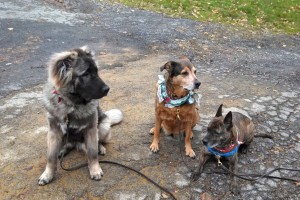Safety Zone: Why Safety Is So Important to Dogs
You make sure that your dogs have a roof over their heads, food to eat and have appropriate vet care as needed. So you assume that they are safe. In comparison to a stray dog, they are indeed safe. But there is a lot more to safety than the basics that I mentioned.
Is any one dog in your home regularly annoying to another dog without consistent human intervention? Do any of your dogs bark constantly at other dogs/humans outside of your home while viewing them from inside? Do any of your dogs bark at other dogs/humans while on a walk? Do you have an invisible fence and allow your dogs unsupervised access to your yard, when it’s on a street with others passing by? Then your dogs might have an emotional safety problem.
There are different degrees of safety. What a dog with one personality may consider a minor worry, another with a higher strung temperament may consider worthy of a meltdown. Learning what your own dogs require in order to feel safe is crucial to having a smoothly running household.
Think about your own emotional state when you don’t feel safe. Do you feel anxious? Worried? Stressed? All of the above? It’s the same for dogs. Safety means something different for everyone. It’s a very individual but very important component of one’s life. How can you determine what safety is lacking in your household? Learning to be very observant about what worry in your own crew looks like and what creates that worry. Learn body language and signals and what questions to the humans of the household look like.
Let’s address some of my examples individually:
Barking more than a little at strangers, from both inside and outside is frequently (but not always) due to anxiety on the dog’s part. Anxiety boils down to a lack of feeling emotionally safe. While this article cannot fix this problem in your dogs, it can give you an idea when you need professional help in order to better create safety in this area. If your dogs are reactive in these types of scenarios, quality professional behavioral help can effect change for the better. Feel free to contact us for a referral to a qualified behavior professional in your area.
I am sure that I will get some flack for my opinions of invisible type fencing, but it has to be said. Unsupervised dogs in most invisible fencing type situations are a recipe for a lack of safety on the part of the dogs, both inside that ‘fence’ and dogs passing by that ‘fenced’ yard. The dogs inside know that anything and anyone can enter their space but they are trapped and cannot get away from an intruder. There is no visible barrier so that passersby are generally seen as a credible threat. This can create and/or increase aggression substantially.
Regarding the subject of one dog annoying another housemate on a regular basis, I have written numerous articles, one on parenting available here and another on dogs who bully other dogs, available here. Knowing that the human(s) in the household will provide safety from being pushed around can allow a dog to truly relax.
This brings me additional clues that your dog doesn’t feel safe. An inability to relax easily around the house is a glaring symptom. Pacing frequently and being easily startled are clues as well. Being hyper-vigilant towards certain criteria such as doorways to the outside world and windows that look out onto potentially active areas of the neighborhood are yet others. A caveat about the interest in the outdoor activity; this can also simply be a habit that has been inadvertently reinforced. When that is the case, you will rarely see the other symptoms.
One of the easiest things that can be done to remedy a lack of emotional safety is to truly see your dogs. Their questions, that is. Dogs ask a lot of questions of their humans. The problems arise when the humans don’t see the questions. The dogs then are forced to deal with their fears in the best way that they know. Pro-active barking is at the top of their list. This rarely works out in a manner that is satisfactory to the humans, or the dogs for that matter!
Feeling safe isn’t limited to the examples that I gave. Other areas of safety include not exposing your dogs to scenarios where they could get into trouble that can be avoided. This can include using a leash when walking outdoors, having your dogs greet visitors away from the initial entry into your home as well as not allowing strangers to touch your dogs without your dog’s explicit permission. See more on that here.
As for the initial examples that were presented, such as meals, vet care and housing, there is lot to be gained from the expectation that basic routines happen predictably enough as expected. Another safety stressor is vast unpredictability on the part of the humans. Behavior wise, that is. If the humans do not behave in a predictable manner most of the time, it can cause instability on the part of the dog’s mental state. Anxious and mentally unstable humans can create or contribute to mentally unstable dogs. This is not always the case, of course. But dogs learn how to walk on eggshells, just like humans. That is not good for either species.
Dogs with rock solid temperaments can certainly safely be emotional or psychiatric service dogs for humans that have emotional problems or mental illness quite successfully. But these are dogs who are hand picked for such tasks, not your average shelter or rescue dog that has baggage of his or her own. However, such dogs will need to have regular breaks in order to remain successful at their task and stable.
In conclusion, with appropriate accommodations made for emotional and physical safety, what you will see is dogs who can roll with life’s challenges and changes. Your crew will trust that you are handling all of the scary things including the handling of scenarios that may worry them. They will trust that they can look to you with questions and get answers that they understand. They will trust that you will intervene when necessary. This allows them to truly relax and be themselves. Creating such an existence among your crew will provide long term peace of mind, not only among your crew but with the humans. Please take the spaces below to describe how you create a safety zone among your crew.
Posted in: Projects
Leave a Comment (2) →





 Humans object to being jostled too, usually by reminding the jostler to be more careful. Dogs get this same privilege provided they can be reasonably polite about it. The key point here is to know your crew. If there are issues, you need to intervene far more often in order to prevent bigger problems.
Humans object to being jostled too, usually by reminding the jostler to be more careful. Dogs get this same privilege provided they can be reasonably polite about it. The key point here is to know your crew. If there are issues, you need to intervene far more often in order to prevent bigger problems.

